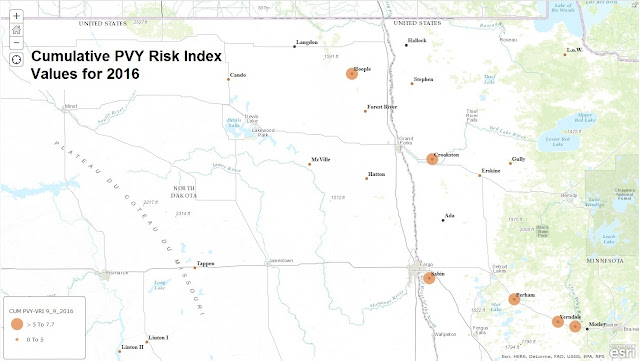Aphid Alert Seasonal Summary
Greetings!
Welcome to the last issue of Aphid Alert for 2017. The harvest has started and most of the vines have been killed. The 2017 season was marked by heavy vector pressure; we had high populations of efficient vector species and they were widely dispersed across the region. This means we had very high risk of PVY transmission. The actual amount of disease that was actually transmitted, however, will depend on how much inoculum was present in each area.
The 2017 wrap up data is posted at the bottom of the page with maps of both 2017 & 2016 PVY Vector Risk Index values. In addition, we've posted a chart of the actual total number of aphids collected by species for each location.
The high number of aphids probably resulted from several factors. A mild winter would have meant high survival of several aphid species that overwinter in MN & ND. The presence of Green Peach Aphid and other species that don't overwinter in the region means we had Low Level Jet stream winds bringing the aphids up from their southern overwintering areas.
Dr, Min Zhu, when she was a PhD candidate in MN back in 2004, established that many of these vector species are re-established annually from aphid populations in states west of the Mississippi River (including Arkansas, eastern Colorado, Kansas, Louisiana, Missouri, Oklahoma and northern Texas). Her work showed that winged aphids from these locations are brought northwards on Low Level Jet (LLJ) wind events. These wind events are (part of the Jet Stream that goes up the center of the continent) are low enough that insects travelling in them won't freeze and they're fast enough to get them up from Texas within 24-48 hours (longer and the insects would dessicate). They're an insect interstate travel route, they transport insects up from the south and deposit them in our region when rain events basically 'dump' them from the sky (bringing a very different meaning to being 'rained out'). Think of LLJs as Aphid Airlines...
Past LLJs can be evaluated using one of NOAA's online tools called HYSPLIT (on the web at: http://ready.arl.noaa.gov/HYSPLIT.php). It uses archvied weather data to determine where LLJs occurred, how long they lasted and what altitudes (NOAA is one of the best record keepers in the world). We used HYSPLIT to 'back track' wind events that hit the Aphid Alert trapping regions early May to mid-June 2017. We found multiple LLJs that coincided with rain events in our region. This means there were lots of opportunities for successful aphid movement from the south.
For example, below is a map showing of a Low Level Jet wind that arrived over Grand Forks on June 10. This event originated in central Oklahoma (well within the area where Green Peach aphids overwinter) and occurred at 1500m Above Ground Level, an excellent altitude for wind to transport aphids that distance. On June 10th, Grand Forks received 0.2" of rain which could potentially have dumped out anything travelling on that wind event. That doesn't mean there were any aphid on that particular flight of Aphid Airlines, but it is a possibility.
There were several LLJs this year that could have impacted many of the areas in our trapping region, which potentially explains the number and wide distribution of Green Peach Aphid this season.
Low Level Jet Arriving In Grand Forks June 10, 2017
2017 Wrap-Up Data
Cumulative PVY Vector Risk Index for the Season of 2017
Cumulative PVY Vector Risk Index for the Season of 2016
2017 Cumulative Total Aphid Species Capture by Trap Location

















































